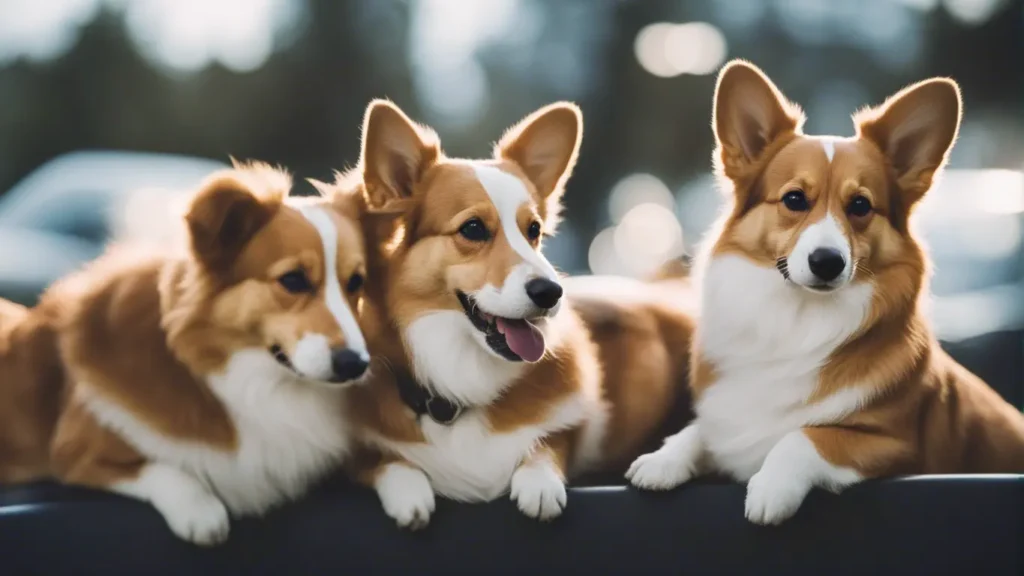Medium dog breeds reach 35-60 pounds and stand between 16-22 inches tall when fully grown. They are larger than small dog breeds but smaller than large dog breeds.
Medium dogs offer the perfect compromise between small and large breeds in many ways. They are small enough to adapt well to apartment living but large enough to be active companions for hiking, running, and other outdoor adventures. Their moderate size also makes them easier to transport than very large breeds.
Medium breeds are among the most popular dogs kept as pets. According to the American Kennel Club, several medium breeds rank very high in popularity, including the Labrador Retriever (#1), Golden Retriever (#3), Bulldog (#4), Beagle (#5), and Cocker Spaniel (#29).
There are several reasons medium dog breeds are so popular:
- They are well-suited to various living situations, from apartments to houses with yards. Their moderate size and exercise needs make them adaptable.
- They have enough endurance and sturdiness for active owners who want to hike, run, swim, or play sports with their dogs.
- Their health and lifespan are often better than those of larger breeds. Medium dogs live 10-14 years on average.
- They are large enough to be protective and make good watchdogs but not so large as to be intimidating to visitors.

When choosing a medium breed, it’s important to consider:
- Activity level – Some medium breeds, like Retrievers, need more exercise than others like Bulldogs.
- Grooming needs – Some have long hair that requires regular brushing, while others have wash-and-wear coats.
- Temperament – Look for a breed whose personality and activity level match your lifestyle.
With so many great medium-sized breeds, selecting the right dog for your home and family is exciting!
The History of Medium Dog Breeds
Medium dog breeds have a long history as beloved companions and working dogs. While large breeds often originated as guard dogs or big game hunters, many medium breeds were bred down from these larger ancestors to be more manageable as pets and workers.
Some key events in the history of medium breeds:
- 1800s – Many of today’s most popular medium breeds emerged in the 19th century. The Golden Retriever was developed in Britain in the mid-1800s as a gun dog able to retrieve waterfowl. The Bulldog was bred in England for bull baiting but later downsized for the show ring and companionship. Boxers also originated in the late 1800s.
- Early 1900s – The American Kennel Club recognized medium breeds like the Beagle, Collie, and Cocker Spaniel in the early 20th century as their popularity grew. Labrador Retrievers became renowned as loyal pets and skilled service dogs during this period.
- World War I – Medium breeds played essential roles during WWI. Boxers worked as messenger dogs, while Red Cross dogs like Doberman Pinschers searched battlefields for wounded soldiers.
- Present Day – Many medium breeds consistently rank among the most popular dogs in the U.S. Labrador Retrievers have been the #1 most registered breed with the AKC since 1991. Golden Retrievers and German Shorthaired Pointers are current favorites.

Some of the most historically popular medium dog breeds include:
- Retrievers – Labrador, Golden, Chesapeake Bay
- Spaniels – Cocker, Brittany, English Springer
- Pointers – German Shorthaired, Vizsla
- Bulldogs – English
- Collies – Border, Bearded
- Terriers – Staffordshire Bull
Today, medium breeds thrive as family pets in roles like search and rescue, hunting, service work, and more. Their versatility and manageable size ensure they will remain popular companion animals.
Medium Dog Breed List
- American Eskimo Dog (Miniature and Standard sizes)
- American Pit Bull Terrier
- American Staffordshire Terrier
- Australian Cattle Dog
- Australian Shepherd
- Basenji
- Basset Hound
- Beagle
- Border Collie
- Brittany Spaniel
- Bulldog (English Bulldog)
- Bull Terrier
- Cocker Spaniel (American and English)
- Dalmatian
- English Springer Spaniel
- Field Spaniel
- Finnish Lapphund
- German Pinscher
- German Shorthaired Pointer
- Harrier
- Ibizan Hound
- Keeshond
- Kerry Blue Terrier
- Klee Kai (Standard size)
- Lhasa Apso
- Miniature Bull Terrier
- Norwegian Elkhound
- Nova Scotia Duck Tolling Retriever
- Pembroke Welsh Corgi
- Plott Hound
- Poodles
- Puli
- Shetland Sheepdog
- Siberian Husky
- Soft Coated Wheaten Terrier
- Staffordshire Bull Terrier
- Standard Schnauzer
- Tibetan Terrier
- Vizsla
- Welsh Springer Spaniel
- Whippet
The Challenges of Owning a Medium Dog
While medium dogs make excellent pets, there are some potential drawbacks to consider:
- Higher costs – Medium dogs eat more food, need more giant crates/beds, and have higher medical costs than small breeds.Budget appropriately and get pet insurance to offset surprise vet bills.
- More exercise needs – Most medium breeds need 30-60 minutes daily, more than small dogs. Commit to daily walks, playtime, or dog sports like agility to meet their needs.
- Difficulty traveling – Medium dogs may be too large to fly in a cabin and too small for cargo, limiting travel options. Look into pet-friendly hotels or RV travel. Use a pet shuttle service for ground transport.
- Housing limitations – Some apartments and rentals have weight limits that preclude medium breeds. Seek out pet-friendly properties without size restrictions. Get approval before adopting.
- Stronger personalities – Medium dogs are often intelligent, energetic, and strong-willed compared to toy breeds. Use positive reinforcement training to shape behavior. Seek a breed that matches your lifestyle.

With proper care, exercise, training, and planning, medium dog breeds make wonderfully loyal family pets. Their moderate size offers the best of both worlds for many owners. Do your research to find the right fit and overcome challenges through preparation and commitment.
How to Choose the Right Medium Dog Breed for You
Your Home and Yard Size
- Medium breeds need adequate indoor and outdoor space to move around comfortably.
- If you have a small apartment or home, look for lower-energy breeds like a Bulldog or Boston Terrier.
- Higher energy breeds like a Labrador or Border Collie may be a good fit in a house with a yard.
Your Activity Level
- Active owners should consider energetic breeds like Vizslas or Standard Schnauzers who need lots of exercise.
- Less active owners may prefer mellower breeds like Basset Hounds or Cavalier King Charles Spaniels.
Grooming Needs
- Some medium breeds require significant grooming (e.g., Cocker Spaniels, Poodles), while others only need occasional brushing (e.g., Boxers, Rat Terriers).
Your Family and Other Pets
- If you have small children, look for breeds known for patience and gentleness, like Beagles.
- Some medium breeds do better in single dog homes (e.g., Dachshunds), while others enjoy having canine companions.

Training Difficulty
- Intelligent breeds like Collies excel at training, while more independent breeds like Basset Hounds may be more challenging.
Your Budget
- Consider acquisition costs plus ongoing costs like food, medical care, grooming, and supplies.
Thoroughly research breeds that seem like a good fit. Meet dogs of that breed to ensure your lifestyle, activity level, and preferences align. Choosing the ideal medium dog ensures a happy life together!
How to Care for a Medium Dog
Medium dogs have some unique care needs compared to small or large breeds. Here are some tips for providing excellent care for your medium-sized dog:
Health
- Get annual vet checkups and keep up with preventative care like vaccines, heartworm medication, and flea/tick control.
- Monitor weight as obesity is common in middle-aged medium dogs. Feed a measured, high-quality diet and exercise regularly.
- Brush teeth weekly and provide chew toys to maintain dental health. Many medium breeds are prone to periodontal disease.
- Adhere to a regular grooming routine to keep their coat and skin healthy.
Exercise
- Most medium breeds need 30-60 minutes of exercise daily, such as walks, playtime, or training activities.
- Mental stimulation is also necessary. Provide interactive toys and use reward-based training to engage their minds.
- Have a fenced yard for safe off-leash play and potty breaks.
- Medium dogs enjoy exploring and running outdoors.

Training
- Use positive reinforcement techniques. Medium dogs are brilliant and eager to please but can be stubborn.
- Crate train your dog and teach good manners like sit, stay, come, down, leave it, and loose leash walking.
- Socialize thoroughly as a puppy to various people, places, dogs, and stimuli to prevent fearfulness.
With proper care, exercise, training, and veterinary attention, your medium dog can live a long, healthy, and happy life as your loyal companion! Let me know if you need any clarification or have additional questions.
Where to Find Medium Dog Breeders and Rescues
Breeders
- Contact your local kennel or breed-specific club for referrals to responsible breeders focusing on medium breeds.
- Attend dog shows and talk to exhibitors about upcoming litters or breeder recommendations.
- Ask your veterinarian if they have breeder contacts they would recommend.
- Search online, but do extra research into breeder reviews and certifications.
- Responsible breeders do health testing on breeding dogs, allow home visits, and take back dogs at any point.
Rescues
- Search sites like Petfinder and Adoptapet for adoptable medium-breed dogs in your area.
- Look for breed-specific rescues like Golden Retriever rescues or Beagle rescues.
- Check local animal shelters and humane societies for medium mixed-breed dogs.
- Ask if the rescue temperament tests dogs and provides medical care before adoption.
- Consider fostering a medium dog first to be sure they are a good fit before adopting.
Research breeders and rescues to find the ideal medium dog for your home. Focus on organizations that prioritize the health and welfare of their dogs.

Medium dog breeds offer the perfect middle ground for many dog lovers. They are small enough to adapt to apartment living yet large enough to be active hiking and adventure companions. Their moderate size and exercise needs make them one of the most versatile and popular choices for new dog owners.
When selecting a medium breed, carefully reflect on your lifestyle and preferences. An energetic breed like a Vizsla will thrive with active owners who can provide ample exercise and training. More laidback owners may find success with a mellower Bulldog or Basset Hound.
Do your research to find responsible breeders and rescues that focus on the health and temperament of their dogs. Budget for the higher food, medical care, and supplies costs compared to smaller breeds. And be ready to commit to providing daily walks, playtime, training, and affection.
With their intelligence, loyalty, and moderate care needs, medium breeds can make ideal family pets for all types of homes and owners. Take your time to choose the perfect canine companion, and you’ll find a lifelong furry friend.